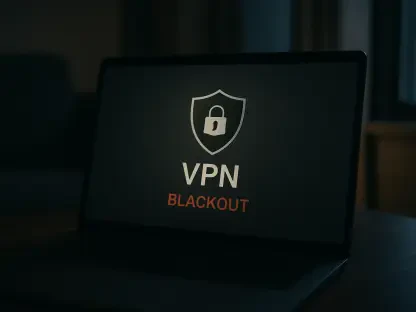In an era where remote work and cloud-based systems dominate the corporate landscape, Zero Trust Network Access (ZTNA) solutions have emerged as a cornerstone of modern cybersecurity, promising to secure access to internal resources by verifying every user and device. However, recent revelations from security researchers have cast a troubling shadow over these platforms, widely adopted as superior alternatives to traditional VPNs. During a high-profile presentation at DEF CON 33, experts from AmberWolf unveiled critical vulnerabilities in leading ZTNA providers, exposing flaws that could allow malicious actors to infiltrate corporate networks. These discoveries raise pressing questions about whether the very tools designed to protect enterprises might instead be creating dangerous entry points for attackers. The implications are vast, as businesses increasingly rely on these systems to safeguard sensitive data and maintain operational integrity in a threat-laden digital environment.
Unveiling Critical Authentication Flaws
The core of the concerns surrounding ZTNA solutions lies in severe authentication bypass vulnerabilities that undermine their fundamental purpose. Research highlighted a specific flaw in a major platform, identified as CVE-2025-54982, which stems from inadequate validation of SAML assertions. This gap allows attackers to impersonate legitimate users and gain unauthorized access to web proxies and internal resources through services meant to ensure private access. Such a vulnerability essentially nullifies the trust mechanisms that ZTNA is built upon, leaving corporate networks exposed to breaches without the need for valid credentials. The gravity of this issue is amplified by the widespread use of these platforms across industries, where a single breach could cascade into significant data theft or operational disruption, highlighting a critical oversight in security design that demands immediate attention.
Beyond isolated flaws, the research also uncovered systemic authentication issues across multiple providers, with evidence of exploitation lingering for extended periods. For instance, another platform’s Identity Provider enrollment mode revealed a bypass vulnerability, tagged as CVE-2024-7401, which has reportedly been exploited in the wild for over 16 months. This flaw is compounded by risks of cross-tenant impersonation due to non-revocable key values, meaning attackers could potentially access data across different organizational boundaries. The prolonged exposure of such weaknesses points to a concerning lag in detection and response, raising alarms about the reliability of ZTNA solutions as a whole. Enterprises depending on these systems may find their security posture compromised by flaws that have gone unaddressed for far too long, necessitating a reevaluation of trust in vendor-provided protections.
Privilege Escalation and Endpoint Threats
Another alarming dimension of the ZTNA vulnerabilities involves privilege escalation risks that directly threaten endpoint security. A notable finding revealed a flaw in a widely used client that enables attackers to gain SYSTEM-level access by tricking the client into connecting to a rogue server. This local privilege escalation issue, still awaiting a CVE assignment, transforms a security tool into a potential attack vector, allowing malicious actors to compromise entire systems from within. Such vulnerabilities underscore a critical paradox: tools meant to fortify defenses can become liabilities if not rigorously tested and secured. For organizations, this means that even trusted ZTNA clients could serve as gateways for attackers to escalate their control over sensitive environments, posing a direct risk to operational continuity and data integrity.
Further compounding the endpoint threat is the discovery of hard-coded credentials in certain ZTNA services, exposing sensitive materials that can be leveraged for broader attacks. One provider’s system was found to contain a static SFTP key, granting access to a server storing client logs with critical authentication tokens. This oversight creates a pathway for cross-tenant data exposure, where attackers could potentially access information belonging to multiple organizations hosted on the same infrastructure. The implications of such a flaw are profound, as it not only jeopardizes individual companies but also undermines the multi-tenant architectures that many ZTNA solutions rely upon. This serves as a stark reminder that endpoint security must be a priority in the design and deployment of these platforms, as overlooking such details can lead to catastrophic breaches across interconnected systems.
Strengthening Security Through Accountability
The breadth of vulnerabilities in ZTNA solutions points to an urgent need for enhanced security validation and vendor accountability. As enterprises place immense trust in these platforms to secure remote access and protect internal assets, the presence of critical flaws—some exploited for over a year—reveals a significant gap in timely patching and configuration oversight. Vendors must prioritize rigorous testing and swift response mechanisms to address vulnerabilities before they can be weaponized by attackers. Moreover, organizations adopting ZTNA must demand transparency from providers regarding security practices and incident response timelines. This dual responsibility is essential to ensure that the promise of Zero Trust does not become a hollow assurance, leaving corporate networks vulnerable to sophisticated threats that exploit implementation shortcomings.
Looking back, the detailed analysis of these ZTNA vulnerabilities underscored a pivotal moment for enterprise security. The range of issues, from authentication bypasses to privilege escalation and data exposure, demanded immediate action from both vendors and organizations to mitigate risks that had persisted undetected for far too long. Moving forward, the focus shifted to actionable steps like adopting robust incident response tools and enhancing Security Operations Center capabilities to detect and neutralize threats swiftly. The lessons learned emphasized that securing corporate infrastructure required a collaborative effort, with vendors strengthening their products and enterprises enforcing stricter oversight. This collective push aimed to transform the setbacks into a foundation for more resilient cybersecurity practices, ensuring that the principles of Zero Trust were upheld through diligent execution and unwavering commitment.









